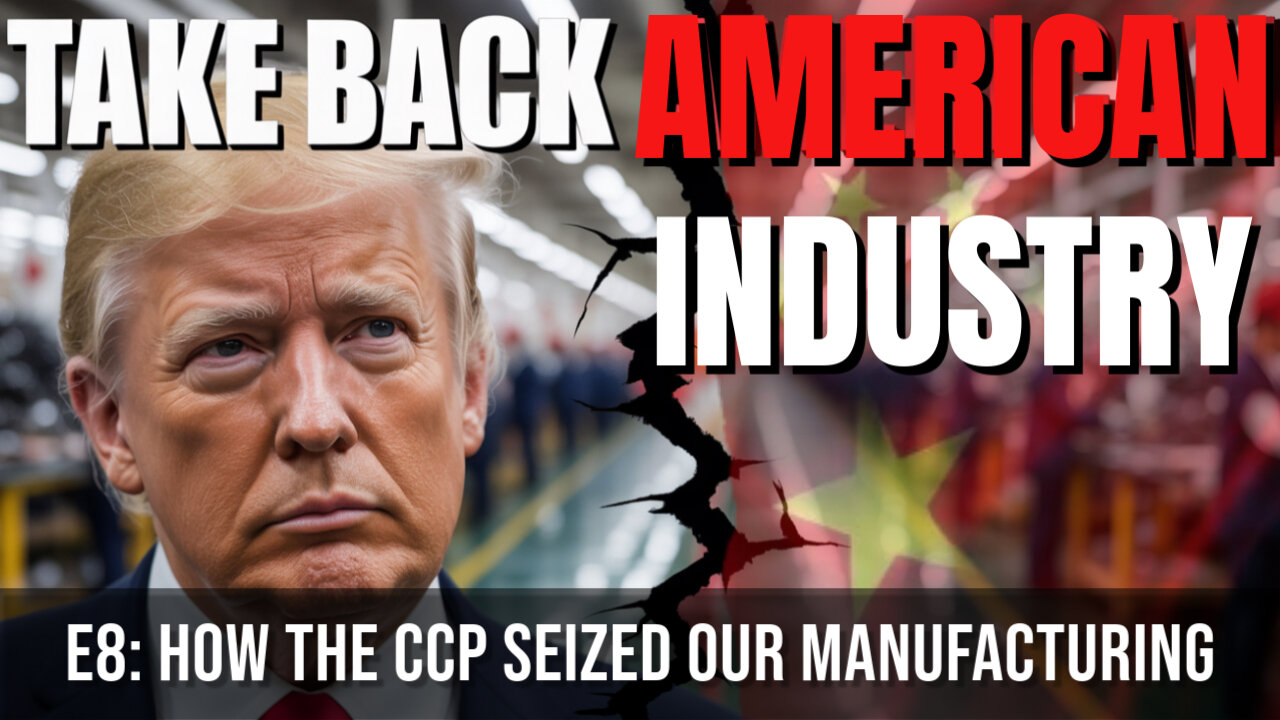Premium Only Content

Taking Back American Industry | E8: How the CCP Took our Manufacturing
In Episode 8 of The Subversion Files, we examine how shifts in global trade reshaped America’s manufacturing base, and how international partnerships accelerated U.S. dependence on foreign supply chains. Through official trade records, university programs, and corporate agreements, we trace how influence expanded beyond factories into classrooms and boardrooms.
This episode documents the mechanisms behind the transition: from large-scale foreign investment in American industry, to educational institutes designed to build cultural ties, to the risks of fragile supply lines in a globalized economy. We conclude with a look at current policy responses and the options available to restore resilience in U.S. production.
#Manufacturing #AmericanIndustry #MadeInUSA #GlobalTrade
#EconomicHistory #SupplyChains #Geopolitics #RareEarths
#IndustrialPolicy #USHistory #TradePolicy #ResilientEconomy
#HistoryPodcast #americaneconomy
Episode 8 — Receipts
Part A: The Real Belt and Road — How China Bought American Manufacturing
Text of U.S. Trade Policy Report on China’s WTO Entry (2001): [USTR 2002 Trade Policy Agenda]
U.S. Manufacturing Job Losses — 3.7 million jobs lost due to China trade (2001–2018): [Economic Policy Institute]
Over 70,000 U.S. factories closed between 2000–2010: [Bureau of Labor Statistics]
Apple, GE, Ford, and others required to share tech in China under joint-venture rules: [Council on Foreign Relations — “Made in China 2025”]
Part B: Tools of the Red Trade — Confucius Institutes, Chambers, and Lobbyists
Senate Homeland Security Report (2019): Confucius Institutes function as arms of the CCP, limiting academic freedom
FBI Director Christopher Wray (2018): Testified that Confucius Institutes are part of China’s “whole-of-society threat”
U.S. Chamber of Commerce: Supported China’s WTO entry, opposed tariffs, aligned with Beijing’s trade agenda
Lobbying Disclosures: Chinese firms (Huawei, ZTE, state-owned entities) retained major U.S. lobbying firms (DOJ FARA filings)
Part C: Endgame — What Happens When the Red Supply Line Snaps
Rare Earth Dependency: China produces 60–80% of global supply, has restricted exports before (2010, 2025): [U.S. Geological Survey]
Antibiotics: 90% of U.S. antibiotics rely on Chinese raw materials: [Congressional Research Service]
Solar Panels: China controls ~80% of global solar panel production: [International Energy Agency]
COVID Supply Chain Shock: PPE, pharma, and electronics shortages exposed U.S. dependency: [GAO Report 2020]
Part D: Strategic Counterpunch — The Battle for Rare Earths
Trump Executive Order (2019): Declared mineral dependency a national emergency; directed agencies to secure supply chains: [White House Archives]
Allied Partnerships: Australia, Japan, EU, and others collaborating with U.S. on rare earth independence: [U.S. Department of Energy]
Verified
The CCP’s strategy of economic dependency is documented through trade records, government reports, and congressional testimony. China’s WTO entry (2001) triggered massive U.S. job losses and factory closures, reinforced by corporate technology transfers. Confucius Institutes and lobbying campaigns extended influence into universities, business chambers, and policymaking. Today, U.S. reliance on Chinese rare earths, pharmaceuticals, and critical technology poses a strategic vulnerability. Federal agencies and allied partnerships are now working to rebuild American independence, but the risks remain.
CREDITS:
Video and images courtesy of: ABC News, NBC News, CBS News, Fox News, Getty Images
Host: Patriot One
Written by: Patriot One
Produced by Patriot One
The Subversion Files is the IP of Patriot One.
-
 25:10
25:10
MYLUNCHBREAK CHANNEL PAGE
6 hours agoIstanbul Should NOT Exist - Pt 4
27.3K10 -
 LIVE
LIVE
tminnzy
6 hours agoDROPS ON - BO7 BETA ALL DAY! #BlackOps7
63 watching -
 1:35:48
1:35:48
Jeff Ahern
6 hours ago $10.30 earnedThe Saturday Show with Jeff Ahern
70K5 -
 LIVE
LIVE
GritsGG
7 hours agoWarzone Win Grinding! Most Wins in WORLD! 3680+!
176 watching -
 55:45
55:45
Tactical Advisor
6 hours agoNew Product Alert! | Vault Room Live Stream 040
56.6K5 -
 3:30:37
3:30:37
Reidboyy
6 hours ago $1.93 earnedTHEY GOT RID OF SBMM WTF!?!? (Go Phillies)
29.8K -
 5:06:48
5:06:48
The Company Boyz
5 hours agoDying Light: The Beast | Ja Pierdole, Kurwa Bober!
24.8K3 -
![Mr & Mrs X - Feminism, Family, Federal Reserve, The Rise Of The [DS] Agenda](https://1a-1791.com/video/fwe2/12/s8/1/6/F/R/n/6FRnz.0kob-small-Mr-and-Mrs-X-Feminism-Famil.jpg) 58:10
58:10
X22 Report
13 hours agoMr & Mrs X - Feminism, Family, Federal Reserve, The Rise Of The [DS] Agenda
207K61 -
 16:37
16:37
Robbi On The Record
2 days ago $9.24 earnedThe Theater of Manufactured Outrage - When Left and Right Dance for the Same Puppet Master
54.1K51 -
 31:27
31:27
Stephen Gardner
1 day ago🔥BOMBSHELL: Mortician EXPOSES Charlie Kirk Autopsy - The Key Evidence EVERYONE Missed!
146K318
